In spite of the stereotype that women are terrible drivers, the number of female drivers nowadays is about even with men, in some countries, there are even more female than male drivers; and yet it all started with one fearless young woman in the turn of the 20th century.
In the more austere time when it was unimaginable for a woman to have an opinion, not to mention operating a vehicle, there was an extraordinary lady who rode cars like a boy, set records, learned to fly, and documented all of her experience so she could inspire women all over the world to pursue their dream as a racing drivers. Dorothy Levitt or “the fastest girl on earth” was the first British woman racing driver, holder of the world’s first water speed record, the women’s world land speed record holder, and an author.
Levitt’s book The Woman and the Car: A Chatty Little Handbook for all Women who Motor or Who Want to Motor, recommended that women should “carry a little hand-mirror in a convenient place when driving” so they may “hold the mirror aloft from time to time in order to see behind while driving in traffic,” thus inventing the idea of the rear view mirror before it was introduced by manufacturers in 1914.
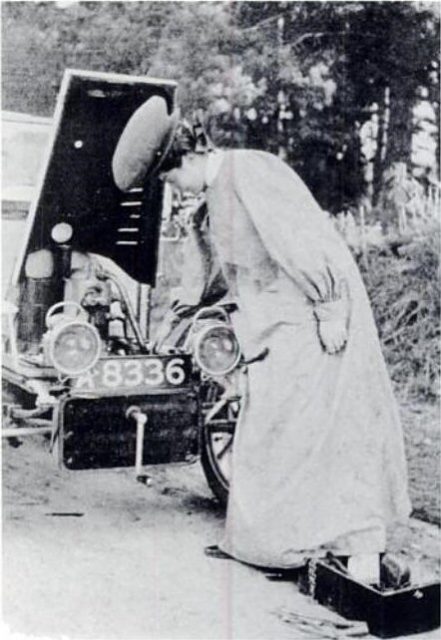
Born in Victorian England in 1882, Dorothy Levitt developed an interest in driving when she worked as a secretary at the Napier & Son works in Vine Street, Lambeth. The turn of the 20th-century saw a transition from the more austere Victorian era towards the dynamics of Edwardian times; transport methods were beginning to change, yet there remained few opportunity for men to race motors, and women driving was almost unheard of.
Levitt had to be taught to drive and Leslie Callingham, a young salesman employed by Napier, was instructed to undertake the task during his day off work. Luckily, Levitt was a fast learner, as Callingham disliked her intensely and was affronted at having to teach a woman to drive. Cars were entered in official trials to accumulate performance information for possible buyers; only the company driver and an official were permitted in the vehicle.
The driver was required to undertake any necessary maintenance during the proceedings, so Edge had to ensure that Levitt was also proficient in mechanics. In later interviews, Levitt described how after Edge had advised her to make a career in automobiles, he arranged a six-month apprenticeship to a French automobile maker in Paris, where she learned all aspects of building and driving cars. On her return to London, she began teaching women how to drive, reportedly showing Queen Alexandra, the Royal Princesses (Louise, Victoria, and Maud), other ladies of nobility and female American tourists.
Levitt’s early experience competing in a motor race took place in April 1903, the first English woman driver ever to do so. She did not feature among the prize winners but determined she would improve in the future. Edge was the British agent for Gladiator vehicles, and that was the marque driven by Levitt during the first year of her career. In May she piloted the 16 hp version in the four hundred mile Glasgow to London non-stop run, losing only six points out of a possible maximum of 1,000; the points reduction was due to having to stop to address a problem with the vehicle’s tires.
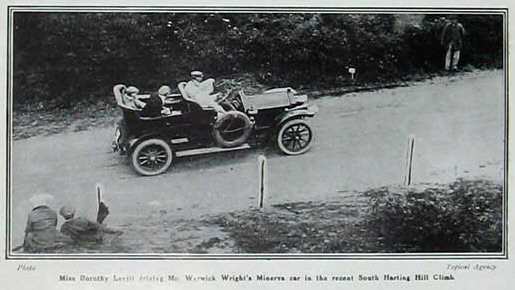
Her vehicle was a non-starter in the Sun-Rise Hill Climb near Edge Hill, Warwickshire on 25 July, so on that occasion she accompanied Edge in his car as an official passenger. Levitt became the first British woman to take part in a speed competition when she made her début in speed races at the Southport Speed Trials, where she won the class for cars priced between £400 and £550 in her four seater Gladiator.
The heats were held on Friday 2 October and the finals on Saturday when she covered the flying kilometer in a time of one minute forty-five seconds.At a time when purchasing cars were only within reach of the aristocracy, and the upper middle classes and women were expected to remain at home tending to their husband’s needs, British society was astonished a woman working in a secretarial capacity was competing in a sport commonly believed to be a male discipline.
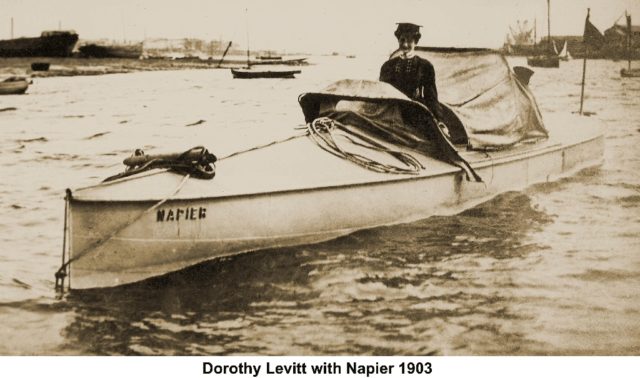
Typically, Edwardian women interested or involved in any mechanical disciplines were perceived to be masculine in outlook, temperament, and style, who would also dress in utilitarian male type clothing. When du Gast competed in the Paris to Madrid 1903 road race, her face was almost entirely obscured by a mask, and she wore a hat that featured ear flaps; her coat was leather and double breasted, and she was assumed to be male until her voice revealed her gender. Levitt, however, raced dressed in flattering feminine outfits complete with co-ordinating hat and veil; a loose, lightweight coat, which became popularly known as a dust coat, afforded overall protection to her fashionable clothes.
Both Levitt’s book and the newspaper column in The Graphic described her atypical lifestyle for the Edwardian era: an independent, privileged, “bachelor girl”, living with friends in the West End of London and waited on by two servants.
In the vernacular of the 1900s, Levitt was a scorcher, a motorist who delighted in exceeding the speed limit and who therefore came to the attention of the police. On 6 November 1903, she was summoned to appear at Marlborough Street Assizes for speeding in Hyde Park. According to the reported statement by the police she was said to have driven at a “terrific pace” and, when stopped, reportedly stated that “[she] … would like to drive over every policeman and wished she had run over the sergeant and killed him.” Although she did not appear personally, the magistrate, Mr. Denman, fined her £5 with 2 shillings in costs. The other six motoring defendants that day were only fined £2 plus costs. In November 1903, Levitt and her friend Hena Frankton claimed damages against a GPO van driver who had hit their car. In two discrete cases, they received compensation of £35 each.
According to a November 1906 interview with the Penny Illustrated Paper, Levitt balanced “the fearful excitement of automobile racing by quietly going fishing, and described trout fishing as her favorite sport. She also described poker as her favorite game and claimed significant expertise at roulette. Outlining her “most wonderful secret system with which she is going this winter to attempt to break the bank at Monte Carlo.”
Levitt was noted for her ever-present, yappy, black Pomeranian dog called Dodo. A gift from Mademoiselle Marie Cornelle around 1903, he had been smuggled into England by being drugged and then hidden in the repair box of an automobile.
Levitt sometimes mixed at the highest social levels, such that her appearances were reported in advance in the Court Circulars of The Times. To wit, her attendance at Major General Sir Alfred Turner’s “Salon reception” at the Picadilly Hotel 14 July 1909.
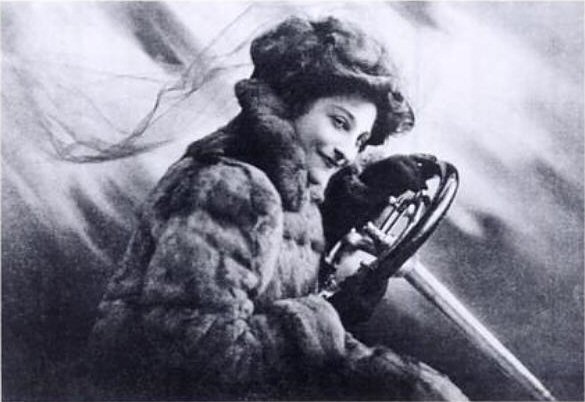
In July 1903 (possibly the 12th) Levitt won the inaugural British International Harmsworth Trophy for motor-boats, defeating the French entry Trefle-A-Quatre. The event was officiated by the Automobile Club of Great Britain and Ireland and the Royal Victoria Yacht Club, and took place at the Royal Cork Yacht Club at Cork Harbour in Ireland. Levitt set the world’s first Water Speed Record when she achieved 19.3 mph (31.1 km/h) in a 40-foot (12 m) steel-hulled, 75-horsepower Napier speedboat fitted with a 3-blade propeller. Selwyn Edge was both the owner and entrant of the boat, and thus “S. F. Edge” is engraved on the trophy as the winner. The third crew member, Campbell Muir, may also have taken the controls. An article in the Cork Constitution on 13 July reported: “A large number of spectators viewed the first mile from the promenade of the Yacht Club, and at Cork several thousand people collected on both sides of the river to see the finishes.”
On 8 August 1903, Levitt drove the Napier motor-boat at Cowes and won the race. She was then commanded to the Royal Yacht Albert & Victoria by King Edward VII where he congratulated her on her pluck and skill, and they discussed, among other things, the performance of the boat and its potential for British government despatch work. Later in August she went to Trouville, France, and won the Gaston Menier Cup. This was reported as “a very competitive race, ‘against the world’s cracks'”, and she won what was described as the “five-mile world’s championship of the sea” and the $1,750 prize.
In 1905, “Levitt established the record for the “longest drive achieved by a lady driver” She drove an 8-horse-power De Dion-Bouton from London to Liverpool and back in two days, without the aid of a mechanic but accompanied by an official observer, her pet Pomeranian dog Dodo, plus a revolver. Her success and skills meant that she was offered works drive in a French Mors in the inaugural RAC Tourist Trophy Race on the Isle of Man, but she was prohibited from accepting by Selwyn Edge, to protect the reputation of his Napier marque. Ironically, the 208-mile (335 km) 1905 event was won by Mr. J. S. Napier in his Arrol Johnson car, ahead of 40 competitors
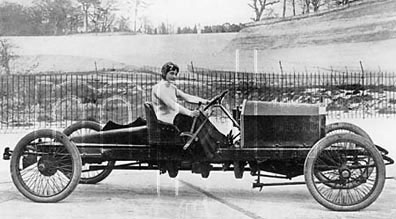
In 1909, Levitt attempted to qualify as a pilot at the Hubert Latham School of Aviation at Châlons Camp Mourmelon-le-Grand, between Châlons-en-Champagne and Rheims in France. She attended along with Marie Marvingt and Baroness Raymonde de Laroche, the only woman ever licensed in the difficult to fly Antoinette monoplane. Levitt became a member of The Aero Club of the United Kingdom in January 1910, and was booked to give a talk at the Criterion Restaurant on Thursday, 3 March 1910 about her experiences learning to fly. According to the Oxford Dictionary of National Biography, she learned to fly a Farman aircraft at a flying school in France in 1910, and by March she was interviewed in the Daily Chronicle about her flying experiences, although there is no record of her having qualified.
Levitt’s career reflected that of several of her contemporaries with a meteoric rise to prominence before abruptly vanishing from public engagements and her life after 1910 is undocumented. She was found dead in her bed at 50 Upper Baker Street on 17 May 1922 in Marylebone according to Probate granted on 27 September 1922
